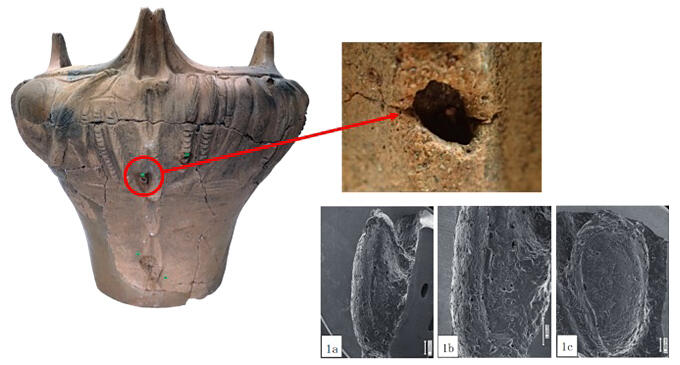Some Jomon period pottery was apparently patterned with pressed soybean seeds. This was discovered when Chuo University, the Kanazawa University Institute for the Study of Ancient Civilizations and Cultural Resources, the Meiji University Center for Obsidian and Lithic Studies and the Tokyo National Museum examined and analyzed mid-Jomon period Katsusaka style pottery excavated from an archaeological site in Fuchu City, Tokyo Prefecture, in February 2021. The discovery was published in "A New History of Fuchu City: Origin and Ancient Times, Complete Edition."

Provided by Chuo University
The pottery unearthed is being held at the Fuchu City Kyodo-no-Mori Museum and was opened to the public at the museum from July 20. In recent years, impression marks remaining on the surface of pottery (marks left by something pressed against the surface) have been attracting attention. In particular, studies using a research technique that collects impressions using the replica method (a method in which silicone is poured into holes in the pottery surface to create a mold for restoring the original shape) have noted that beans were cultivated during the Jomon period.
A research team from the Chuo University Archeology Laboratory and their collaborators, in cooperation with the Fuchu City government's project to publish a new history for Fuchu City, examined pottery excavated from the Shimizugaoka site, a large settlement from the mid-Jomon period in Fuchu City. Seven recessed impressions were found on this pottery in the area where clay had been attached to form linear ridges as decoration. The impressions on the pottery were reproduced using the silicone replica method, and the replica was identified using a stereomicroscope and specimens from the collection of the Meiji University Center for Obsidian and Lithic Studies. Based on the replica's morphology, the impressions were identified as belonging to a single taxonomic group: seeds and cotyledons (seed leaves) of herbaceous plants of the soybean genus.
The soybean genus includes wild Glycine soja and the cultivated soybean species. The maximum and minimum lengths of the five measurable soybean seed impressions obtained in this study were 12.2 mm and 8.25 mm, respectively. All impressions exceeded the maximum length of 10 mm of the present wild G. soja, except for one (8.25 mm) which had an irregular shape. One piece of pottery had multiple impressions of cultivated-size soybean seeds, and the seed impressions were found only on the ridges where the seeds had been attached when the design was applied, as if they had been pressed against the pottery surface from above and embedded. It is believed that the seeds were not accidentally mixed in during pottery production but were intentionally embedded as decoration before the pottery was fired.
In some cases, in the Kanto region, a large number of seed impressions have been found on a single piece of pottery from archaeological sites of the early Jomon period and thereafter. However, there has been no clear evidence of a large amount of seed impressions on a piece of pottery where the seeds were intentionally embedded in the pottery. This is an important discovery for the reconstruction of plant use during the Jomon period and for exploring some of the spiritual and cultural activities of the Jomon. Based on these results, the research group will continue to investigate and study whether other similar practices existed, and whether soybean was cultivated during the Jomon period.
This article has been translated by JST with permission from The Science News Ltd. (https://sci-news.co.jp/). Unauthorized reproduction of the article and photographs is prohibited.




